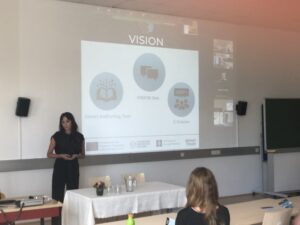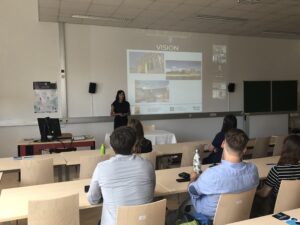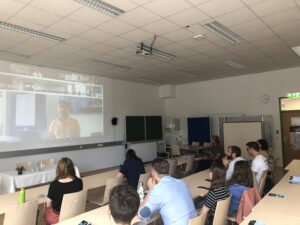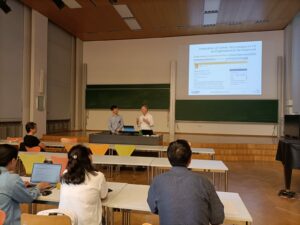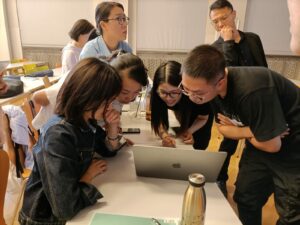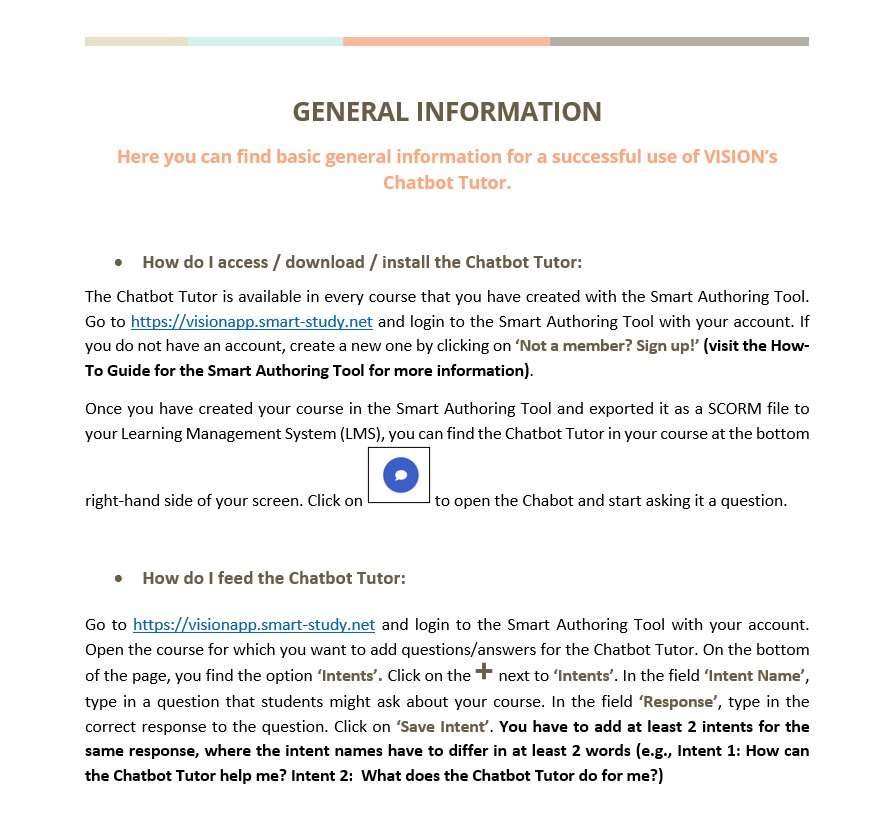VISION and ChatGPT
k.m.j.vanelsen
June 2023
The release of chatGPT stirred a lot of interest in chatbots. During the VISION project focus groups, we got several questions about how they compare.
In a nutshell, they have similar functionality but a very different use case. Chat-GPT trained on a big part of the public Internet. This means chatGPT can handle questions about a wide variety of topics. It returns a generic answer based on the patterns the neural net found while training.
The VISION chatbot has a more specific purpose. To train on and give answers about private course information. It can do this based on course information and personal student data. This information is used to deliver a more tailored experience to a student.
For the best learning experience, students could combine the strengths of both chatbots. The VISION chatbot can provide quizzes about specific content and track the student’s progress. The VISION bot will then give the student feedback on the topics they could study further. Taking this information to a bot
like ChatGPT will enable the student to find more information and extra content to get a deeper understanding.
The result will be a more individual study experience empowered by a combination of bots.
August 2023 Newsletter

Final Conference Photos University of Graz
Final Conference Photos University of Amsterdam
Final Conference Photos TU Dresden
Final Conference
July 2023 Newsletter

Final Conference
PROGRAM
15:00-15:10 WELCOME
Rudolf Egger, Institute of Educational Sciences, Graz
15:10-15:20 PROJECT PRESENTATION
Sandra Hummel, Project coordinator, Graz
15:20-16:15 KEYNOTE
Eric Mazur, Balkanski Professor, Harvard
16:15-17:15 VISION TECHNOLOGIES
Sebastian Starke, Graz; Boxuan Liu, Dresden; Natasa Brouwer, Amsterdam
17:15-17:20 CLOSING REMARKS
Sandra Hummel & Rudolf Egger, Graz
17:20-19:00 ON SITE ACTIVITIES & BUFFET
We are looking forward to welcoming you at this event and to an inspiring exchange
June 2023 Newsletter

June 2023
UvA Education Day
VISION was presented at the UvA Education Day on May 23rd. Ana, UvA’s team coordinator, and Koen, a VISION team member at UvA, presented the project in a group session on ‘Synergies and Friction Between Imagination and Technology’. Their session was part tutorial, part reflection. First, they leveraged the VISION tools to explore imagination in creating new course material, after which they reflected on the imagination and technology synergies and friction points, by starting from the imagination exercise of ‘In a world where everyone can see the power of ChatGPT and other conversational chatbots, what would we like to add to the arsenal of higher education courses to increase the learning effectiveness while lowering the workload of the teaching staff.’

June 2023
Focus Groups
In May, we held our focus groups to receive feedback from Higher Education Teachers and Higher Education Students on our tools. We want to thank participants again for their participation. Their feedback is valuable in further improving our intellectual outputs so that teachers and students can maximally profit from them.
May 2023 Newsletter

May 2023
Final Conference
The keynote speaker at our final conference will be Eric Mazur.
Eric Mazur is a Professor of Physics and Applied Physics at Harvard University, widely recognized for his significant contributions to higher education. He founded Peer Instruction, an effective teaching methodology that enables interactive and engaging classroom experiences for large lecture classes. Prof. Mazur’s work has had a huge international impact, including groundbreaking work in the development of the flipped classroom approach, and an active role in improving higher education by providing innovative teaching methods that utilize digital technology and AI.
He co-founded Perusall, an application that uses AI to enhance student engagement and learning, allowing students to collaboratively read and annotate texts for an interactive and personalized learning experience. His innovations in teaching and learning have had a significant impact on higher education, making Prof. Eric Mazur one of the most influential academic teachers in the world, with a lasting effect on how we approach teaching in the classroom and support students’ learning.
May 2023
Save the Date for our Final Conference
We can proudly announce that we have a date for our Final Conference. Mark the 28th of June in your calendars. Thr final conference will take place simultaneously in all partner countries (Austria, Germany and the Netherlands). Besides the on-site activities, we will have a shared online session where we will introduce our intellectual outputs and hear our keynote speaker, Eric Mazur, talk about technology in education.
April 2023 Newsletter

April 2023
Check out our E-Course
In the past couple of months we have worked hard at creating our support course to VISION’s intellectual outputs. The how-to guides are ready and we are currently working on the video tutorials. Take a first peek at what we have so far.
April 2023
Check out our Smart Authoring Tool
We have moved the Smart Authoring Tool to a new domain: https://visionapp.smart-study.net/login
The Tool allows you to create your own course which can be structured into sections and, within sections, into units. You can add different forms of media such as text, pictures or videos. Or import your external HML source.
The Chatbot Tutor is now integrated into the Smart Authoring Tool. You can create intents for your course and feed the Chatbot with it.

March 2023 Newsletter

March 2023
Our Intellectual Outputs used in Moodle
Look at a first version of a course created with the Smart Authoring Tool used in Moodle.
March 2023
Transnational Project Meeting Graz
From March 7th-8th, Smart Study hosted the third VISION transnational project meeting. This two-day meeting was held at Smart Study’s office which is located right next to the University of Graz main building.
Program of the meeting
Day 1: 7 March 2023
• Welcome
• Overview of the project (All intellectual outputs and their current status)
• Final conference (Keynote speakers)
• Housekeeping (Timesheets, Dissemination, Internal Evaluation, Homepage, Interim/Final Report; Questions, Other input)
• Chatbot and focus groups (TUD presents Chatbot Tutor with its functions)
Day 2: 8 March 2023, 09:00-13:00
• Working group
• Conclusion (Plan ahead; Meetings in the future)

February 2023 Newsletter

February 2023
Chatbot Functions

February 2023
Chatbot for Teachers
Check out TUD’s visual for teachers on how to work with the Chatbot.

January 2023 Newsletter

January 2023
Updates from Smart Study
The last weeks and months turned out to be very eventful for Smart-Study.
In September Smart-Study was an exhibitor at Digital X, taking place from September 13th-14th, the largest trade show for digitalization in Europe. Three team members had the opportunity to promote the Smart Authoring Tool to a large number of international visitors.
In November, Michael Reiger, Smart Study’s CEO and team coordinator, took part in VISION’s transnational meeting in Amsterdam to present the current status of the Smart Authoring Tool and to discuss the integration of the Chatbot into the Smart Authoring Tool.
As a result of this meeting in Amsterdam, intensive work was done on the further development of the Smart Authoring Tool. For example, a sophisticated quiz function was added and a first version of the chatbot was integrated into the tool.
January 2023
What are Intents?
In regard to chatbots, the word ‘intent’ refers to the user’s intention. What is their goal when interacting with a chatbot or simplier put: what does the user want? In VISION’s case the users are students and what they want is to obtain information from the chatbot. This information is linked to a specific university course created through the Smart Authoring Tool. In a course on “Assessment”, for example, students might want to know what a ‘rubric’ is. They have heard about it in their course, but at home, they cannot remember the specifics. The chatbot answers to this intent. However, in order to work properly, the chatbot needs a set of intents, or in other words, one question with different ways to ask it. This might be “What is a rubric?”, “What does a rubric do?”, “How is a rubric used?”. The answer the students are looking for is always the same.
December 2022 Newsletter

December 2022
UvA Education Day
Check out Ivan’s Poster on VISION! He presented the project at University of Amsterdam’s Education Day which took place on Thursday October 6th and focused on ‘Learning as a Community’.

December 2022
Update Project Outputs
Check out our Miro-Board for improving the Authoring Tool. A result from our transnational project meeting in Amsterdam.

Check out our Miro-Board for improving the Chatbot Tutor. A result from our transnational project meeting in Amsterdam.

November 2022 Newsletter

November 2022
Chatbot News
A lot has happened in the development of the Chatbot this month. We prepared the servers of the TU Dresden for the migration of the data, carried out some “cosmetic” work to increase usability, and supported Smart Study in the integration of the Chatbot into the Smart Authoring Tool. In addition, we tested both tools at the meeting in Amsterdam.
After we implemented the basic functions of the Chatbot, now additional work follows; small graphic elements are refined in many places. The new UI&UX design solved problems of the old version. The input of possible questions is one example. The users do not need to type the dash (-), space and the line break between each intent any longer. Now, there will be an individual input field for each intent. By clicking the plus sign and minus sign, the users can increase and delete intents. What needs to be mentioned is that the users should make at least two intents to make the system work.
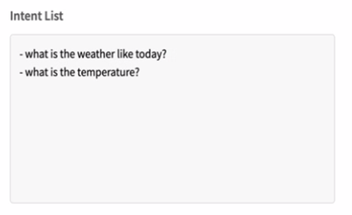

In addition, we supported Smart Study in the integration of the Chatbot. The programmers got together and compared the data structures of both systems. They noticed that they used different course structures. The Smart Authoring Tool is in use and therefore it had offered hardly any options for customization, so we adjusted the structures on the Chatbot side accordingly. Thus, the integration can be carried out by Smart Study in good time. Finally, a brief insight into the workshop in Amsterdam. The aim was to give the Graz Team suggestions for the tutorials on the Authoring Tool, Chatbot Tutor and the how-to video content. We tested the tools without specific instructions and the participants noted down problems and obstacles they encountered. These can now provide a starting point for further development and for the users’ assistance.
November 2022
Transnational Project Meeting Amsterdam
From November 29th – 30th, the University of Amsterdam hosted the second VISION Transnational project meeting. This two-day meeting was held at the Amsterdam Science Park in Lab42, the new building of the Faculty of Science that is fully devoted to computer science and artificial intelligence.
The programme of the VISION transnational project meeting in Amsterdam was intensive and productive. On Wednesday, November 29th, the project partners discussed project organizational topics and the progress of all three intellectual outputs: the Smart Authoring Tool, the Chatbot Tutor, and the E-Course. The partners could conclude that the project is on schedule. Next, Erwin van Vliet (UvA) presented IguideME, the learning analytics tool developed at the Faculty of Science (UvA) followed by a discussion.
On Thursday, two workshops were organized on “Simulation of the creation and development of measures.” First there was a hands on workshop on the Smart Authoring Tool, and next the Chatbot was tested by all partners. It was a great experience to explore these tools in working and to prove that they can be integrated into digital learning platforms like Canvas. The feedback from the participants in the workshop was carefully collected and will be used by the developers to improve the tools.
In the final discussion, partners set up for the next steps and made the necessary appointments.
Programme of the VISION transnational project meeting in Amsterdam
Wednesday, 29 November 2022
- Welcome by UvA Team and Sandra Hummel (University Graz) (13:00-13:10)
- Overview of the project (13:10-13:40)
- Overview, plan, goals
- Chatbot and focus groups (13:40-14:10)
- Housekeeping (14:10-14:50)
- GDPR
- Timesheets
Break (14:50-15:00)
- Erwin van Vliet (University of Amsterdam): IguideME (15:00-16:00)
Break (16:00-16:10)
- Plan ahead (16:10-17:00)
- Last transnational meeting in Graz
- Final conference
- Meetings in the future (dates)
- Conclusion
- Social dinner
Thursday, 30 November 2022
- Workshop, Topic: Simulation of the creation and development of measures (9.00-12.30)
- Phase 1: Smart Authoring Tool
- Phase 2: Chatbot
- Closing discussion and final agreements (12.30-13.00)
- Lunch and farewell

October 2022 Newsletter

October 2022
Open Access
You might have seen scholarly publications online labelled with Open Access (OA) and you were not sure what it means. The main aim of Open Access is making papers, books, reports and other kinds of publications (also data) open and available to everyone. Those publications are available online and free to download without payment or registration. Such publications make scholarly information and output widely available. It also “increases visibility and reuse of academic research results” (What is Open Access?).
Source:
What is Open Access? What is open access? (n.d.). Retrieved November 2, 2022, from https://www.openaccess.nl/en/what-is-open-access
October 2022
GitHub
 GitHub, the Internet hosting service which uses the “octocat” as its mascot. But What is GitHub and what makes it so great?
GitHub, the Internet hosting service which uses the “octocat” as its mascot. But What is GitHub and what makes it so great?
GitHub is a hosting service for a variety of different projects, but it is mainly known for hosting software projects. In fact, “GitHub has in recent years become the world’s biggest collection of open source software” (Finley, 2015). Due to an extensive archive and database for codes, GitHub can be a valuable source for all kind of projects, including the VISION project.
Source:
Finley, K. (2015, June 29). The Problem with Putting All the World’s Code in GitHub. Wired. Retrieved November 2, 2022, from https://www.wired.com/2015/06/problem-putting-worlds-code-github/
Let’s Build from Here. GitHub. (n.d.). Retrieved November 2, 2022, from https://github.com/
September 2022 Newsletter
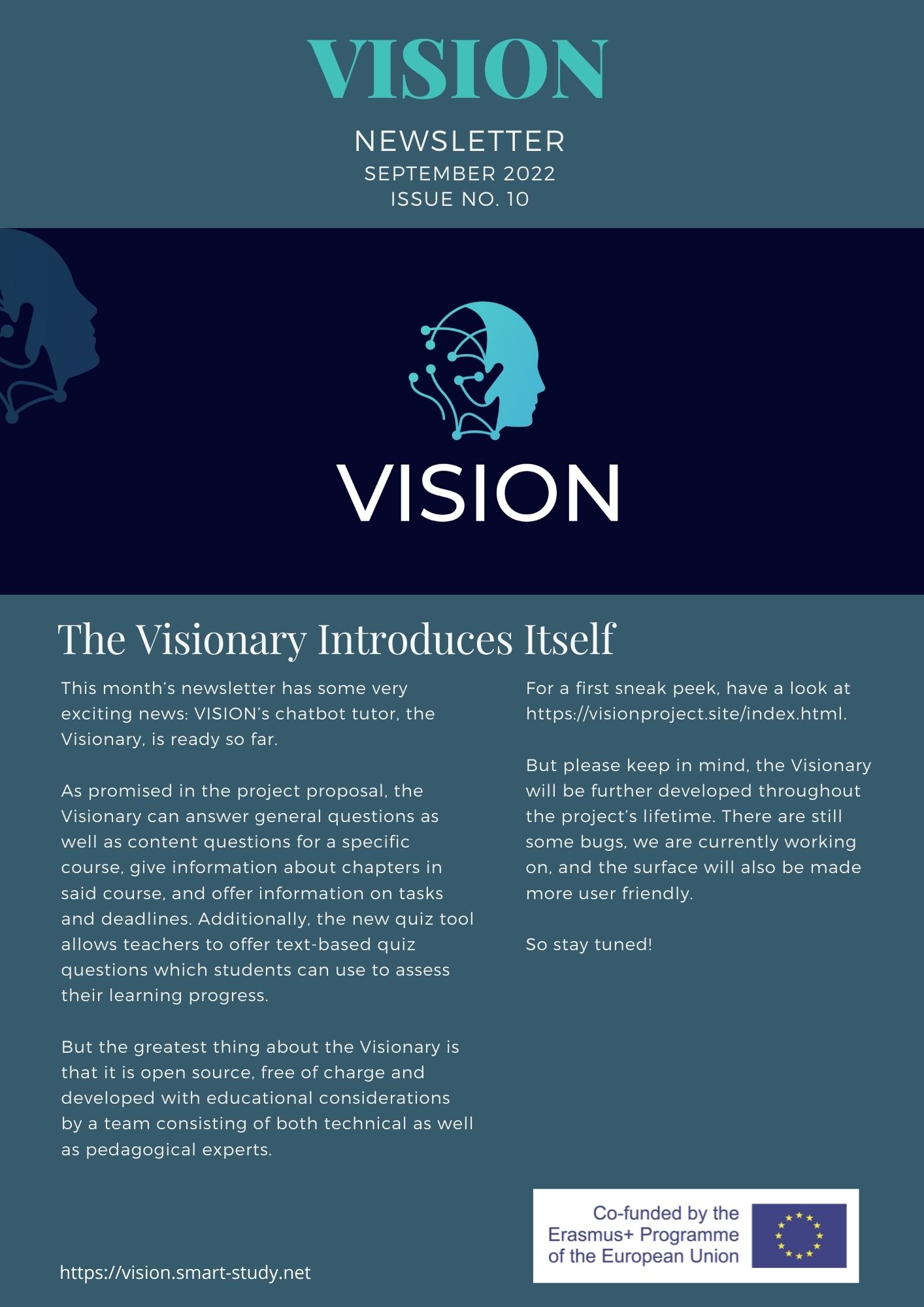
September 2022
International Conference: ÖFEB (Austrian Society for Research and Development in the Educational Field)
 Sandra Hummel, the project coordinator and team member at the University of Graz, presented VISION’s chatbot at the ÖFEB (Austrian Society for Research and Development in the Educational Field) Congress taking place in Graz from September 20th to 23rd. She discussed the educational benefits of a chatbot to the teaching/learning process by enabling personalized and adaptive learning.
Sandra Hummel, the project coordinator and team member at the University of Graz, presented VISION’s chatbot at the ÖFEB (Austrian Society for Research and Development in the Educational Field) Congress taking place in Graz from September 20th to 23rd. She discussed the educational benefits of a chatbot to the teaching/learning process by enabling personalized and adaptive learning.
The presentation received very positive feedback, especially from students with special educational needs. Thank you for showing interest and please keep in contact so that we can optimize the tool to your needs.
Photo source: “ÖFEB Kongress 2022_EW (16)” by Pädagogische Hochschule Steiermark (2022) is licensed under CC BY-NC-SA 2.0
September 2022
Chatbot Workshop
At the end of September, we had a 1-hour online train-the-trainer style workshop to learn what the project’s chatbot, the Visionary, can already do, how we can work with it in courses and how students can benefit from it.
This format was very successful, and we will keep it for further training of staff using the Visionary. We are currently planning on offering these workshops every 4-6 weeks as a support for teachers who want to make use of the Visionary.

August 2022 Newsletter

August 2022
The Human in the Loop
Our Chatbot Tutor is smart, but it might not always know the answer. Therefore, we are developing a “human in the loop” function to make sure all user questions are answered. The way it works is that any time the bot doesn’t know the answer to the questions, it will forward it to the creator of the course, the teacher. The teacher will then answer the question using the same chat function. Questions and teacher answers are then saved and forwarded to the bot. This is done in order to further train the bot. The question-answer pairs that are generated from the communication between the learner and the teacher are then added to bot’s knowledge base. Pretty clever!
This has just been implemented and we are excited to test it out!
August 2022
Chatbot Tests
The team met online to test our trusty Chatbot Tutor to see how well it deals with responses that are intelligible. Good job Chatbot. Thanks for passing it on to the human in the loop.

July 2022 Newsletter

July 2022
Chatbot Quiz Function
The latest advances in the Chatbot are focused on the creation of quizzes that contain questions with multiple choice options for exam preparation. The web interface is easy to use for the teacher.

When student wants to study for an exam, they can call up the quizzes available in the course. The Chatbot performs automatic feedback after the student chooses the options by giving positive reinforcement with “Correct!!” or providing the correct answer. At the end of the quiz, the score that the student has achieved is displayed and saved in a database and will be used for a performance report.

The Feature is currently in the testing stage and we hope to make it available to end users soon.
July 2022
E-Course Activities in Development Phase
Now that the learning outcomes, course objectives, course structure and timing have been established, Uni Graz and UvA are working hard on creating interesting, useful and practical activities for future E-Course participants. Currently activities include:
- short readings on artificial intelligence in teaching and learning in higher education
- tutorials on the Authoring Tool and Chatbot Tutor
- how-to video content
- practice and application exercises
- reflection
We can’t wait until it all comes together. It is going to be a wonderful course!
June 2022 Newsletter

Let's Chat! Chatbot Testing Interface
June 2022

Students at TUD and Uni Graz are working on feeding and training the Chatbot Tutor in both German and English. The process is simple. Students first make contact with the Chatbot through Telegram. Next, students ask the Chatbot questions about a predetermined course. If the bot answers the question correctly, the student moves on. If the bot is unsure of the answer, the student enters the question and answer into a database which will then be updated by TUD so that the bot can answer the question next time. This process tests the usability of the interface, the accessibility of the dissemination channels offered by the AI, the use of hardware resources on the servers during the training, the interaction of the students with the chatbot, and the occurrence of errors and exceptions, the causes, and the AI decision making process. Plus, chatting with a bot and watching it learn in real time is quite entertaining! Oh, what the future will bring.
International Conference: Digitalization in Higher Education
June 2022

The VISION team was thrilled to finally meet in person and present the project to all our guests at the event: Digitalization in Higher Education. We heard from various presenters including Lasse Rouhiainen (best-selling author and international expert on artificial intelligence, disruptive technologies and digital marketing), Dr. Martin Ebner (TU Graz), and Dr. Michael Kopp (head of the Center for Digital Teaching and Learning at Uni Graz). We also heard from each project partner and the Dean of the Faculty of Environmental, Regional and Educational Sciences at Uni Graz. Thanks to everyone for coming and participating in fruitful discussions afterwards!
May Newsletter

UvA's Requirement Review Process
May 2022
What goes into creating the Smart Authoring Tool and the Chatbot? The first order of business is a requirements review! Here is the process UvA went through in order to carry it out.
- They collected state-of-the-art and state-of-practice data.
- They checked the feasibility of the set of desirable requirements with the VISION technical development partners at TUD and Smart-Study.
- Based on their input, they filtered a subset of desirable and feasible requirements.
- From these requirements, they constructed a set of features.
- They proceeded to construct mockups of these agreed upon features.
- They sent them to the development team for review.
And the process continues! Stay tuned.
What is SCORM?
May 2022

The courses in the Smart Authoring Tool are exported as SCORM packages. But what are these SCORM packages and what are the benefits of them?
SCORM (Sharable Content Object Reference Model) is an international standard for e-learning courses. If a course is published in the SCORM format, most learning management systems (LMS) will be able to read it and to show the content inside.
Before the SCORM standard was established, courses that were created in one LMS could not be used in another. In 2001, the SCORM format was established as an advanced standard and is the most common standard for e-learning courses. The SCORM Standard is a list of requirements for eLearning courses. Once the requirements on the list are met, the courses work on any platform and thus become shareable.
Thanks to the SCORM standard, the AI-based courses created as a part of VISION can be used across all of the LMSs of the University of Graz, TUD, and UvA and whichever universities use VISION in the future!
April Newsletter

Natural Language Processing and the Chatbot
April 2022
There are different types of chatbots commonly developed for customer support. Chatbots based on regular expressions and word recognition are developed for a specific purpose. The VISION project’s chatbot is based on natural language processing or NLP. NLP is a branch of artificial intelligence that helps computers understand, interpret and manipulate human language. NLP uses elements from many disciplines including computational linguistics.
An understandable interface is currently being developed at TU Dresden for teachers to feed the knowledge base for the chatbot to provide answers to students about the organization and content of the course. This tool will be integrated with the Smart-Authoring tool.
Below is a provisional interface to feed a knowledge base to the chabot to provide answers to sentences written by students in natural language.

This makes it easier for teachers to avoid having to familiarize themselves with NLU concepts such as intent, entities and domains. It will also allow students to ask questions about the course and its content without having to reach out to the teacher.

Ultimately, the chatbot will be able to have more in depth conversations with students to answer specific questions about the content. To do this, it will pull information from its knowledge base.


March Newsletter
March 2022

Quizzes and Other Assessment Tools Added to Smart Authoring Tool
February 2022
Smart-Study and the University of Amsterdam (UvA) have been working hard on the features of the Smart-Authoring tool, specifically for creating formative assessments and quizzes. Firstly, the teams looked at existing tools and their designs including Adobe Captivate, Lectora, and Articulate. The UvA-team came up with some pros and cons for each tool. For example, Adobe Captivate had a large variety of questions and a basic look while maintaining enough customization. Lectora offers even more customization but is way too complicated for new users. Articulate shows a clean default look and is intuitive but lacks the customization VISION might need.
Using this feedback, UvA created mockups. The goal was to create a first draft design that could be used to start developing the formative assessment feature within the Smart-Authoring tool. The design philosophy is to create an intuitive tool that is easy to use while still offering enough customization if needed.
Smart Authoring Tool Developments
February 2022
February Newsletter
February 2022

Smart Authoring Tool Progress from Smart-Study
February 2022

Smart-Study presented their progress on the Smart-Authoring tool to the team in a virtual meeting. The team has been making great progress and will soon be ready to start testing courses from the partner universities. We were all quite excited to see the ideas come to life and evolve!
January Newsletter
January 2022

TUD Begins Testing Bot Functions
January 2022

Currently about 150 students have started to work with a preliminary version of the VISION Chatbot Tutor while studying educational technology in the lectures of project member Prof. Dr. Thomas Köhler from TU Dresden. In addition to practical usage, students also reflect on their experiences with AI technology in form of a essay as part of their written examination to develop an even better understanding of future teaching technologies as they progress. We are very excited to start seeing the results of the preliminary testing!
Consortium Meeting One
December 2021

Although we had planned our first consortium meeting to be in person in Dresden, COVID changed everything once again. We were, however, not bitter! We met online to discuss the project and made the most of it. We talked about our risk assessment strategy, began developing questions for our chatbot and covered some administrative items. The entire team is hoping that one day soon we will meet in person.
December Newsletter
December 2021

Here is a look at our December newsletter, which wraps up the first six months of the project.
Sneak Peek of UI for Smart Authoring Tool
November 2021
Hot off the press from Smart-Study, here is a first look at the visual layout for the Smart Authoring Tool! These initial mockups help the team put visual layout ideas onto a canvas so that everyone is on the same page. Graphical design, colors and other similar concerns will be discussed at a later stage.
Chatbot Functions
October 2021

Mapping out the chatbot functions is the first step in understanding how all of the elements will work together to create our great Visionary!
International Research Day at Uni Graz
October 2021

VISION team members from Uni Graz presented VISION at the annual Research Day in front of faculty members and students. There the team discussed the goals of the project and inspired a conversation about the future of education in an ever changing digital landscape.
Planning the E-Course
August 2021
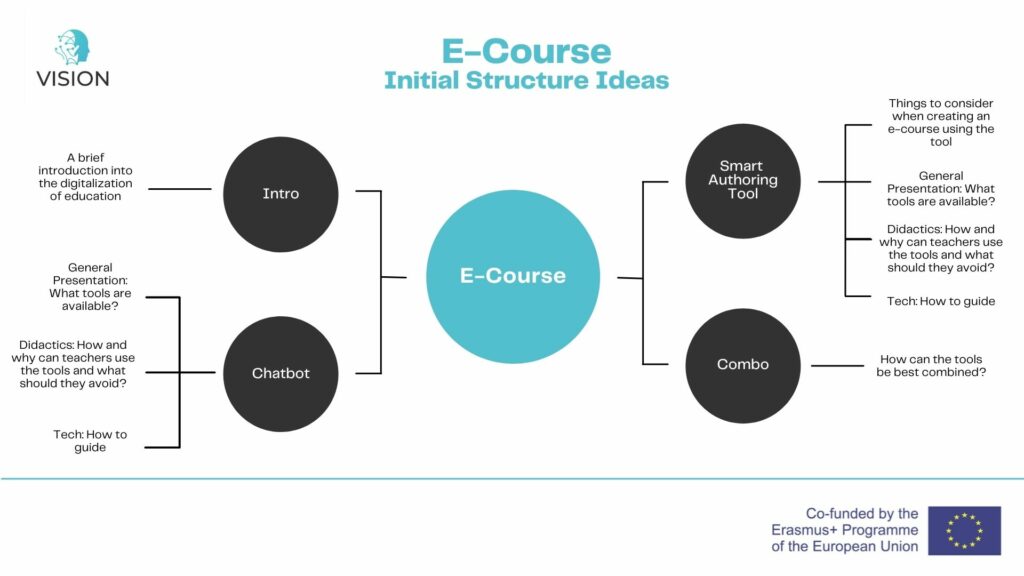
UvA and Uni Graz sat down (virtually) to discuss the initial ideas for the E-Course structure. These ideas were visualized in a mind map to present to the larger team. Off to a good start!
Visualizing the Chatbot Workflow
July 2021

Setting the structure of the workflow is an extremely important step! Below is an idea of our team’s initial workflow ideas. Perhaps this will change and evolve, but we are off to a good start.
Building a Chatbot
June 2021
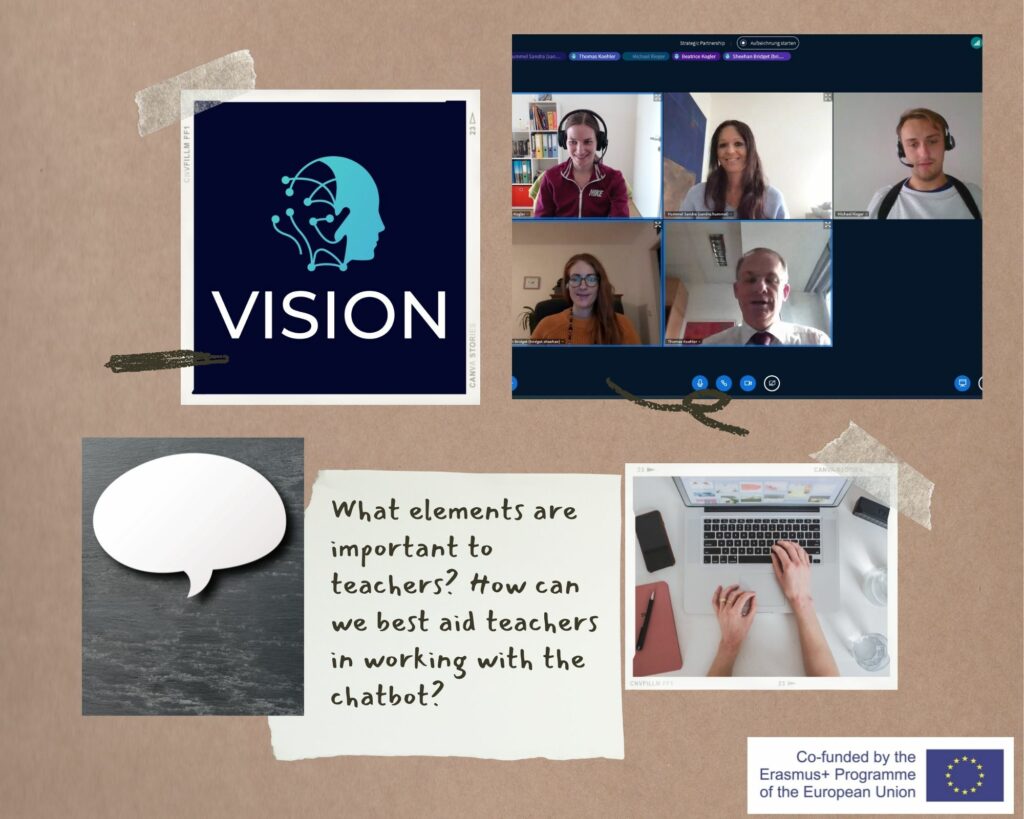
Building a chatbot tutor is extremely exciting, fun, interesting and yes, complicated! Our goal is to create a chatbot that can simulate student-teacher interactions through a messaging application embedded directly in the LMS. As we begin building this bot, we have to find out what elements will be most important to teachers when using the bot and how we can adapt the bot to ensure its implementation in every course, language and at every university. As we move forward, we are starting to understand all the moving parts that will help make this a success.
The Launch of VISION
June 2021

After much hard work, the day has finally come: VISION has launched! While the kickoff meeting was not in-person (as we had initially planned), we were able to engage in productive conversations and get to know one another through two days of online meetings. We covered administrative details and dissemination and began our first detailed technical talks for the three intellectual outputs. The entire consortium is looking forward building the chatbot, smart authoring tool and the e-course.


